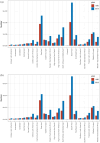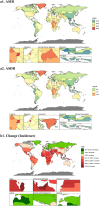Temporal and spatial trend analysis of all-cause depression burden based on Global Burden of Disease (GBD) 2019 study
- PMID: 38811645
- PMCID: PMC11137143
- DOI: 10.1038/s41598-024-62381-9
Temporal and spatial trend analysis of all-cause depression burden based on Global Burden of Disease (GBD) 2019 study
Abstract
Depression has been reported as one of the most prevalent psychiatric illnesses globally. This study aimed to obtain information on the global burden of depression and its associated spatiotemporal variation, by exploring the correlation between the global burden of depression and the social development index (SDI) and associated risk factors. Using data from the Global Burden of Disease study from 1990 to 2019, we described the prevalence and burden of disease in 204 countries across 21 regions, including sex and age differences and the relationship between the global disease burden and SDI. The age-standardized rate and estimated annual percentage change were used to assess the global burden of depression. Individuals with documented depression globally ranged from 182,183,358 in 1990 to 290,185,742 in 2019, representing an increase of 0.59%. More patients experienced major depressive disorder than dysthymia. The incidence and disability-adjusted life years of depression were the highest in the 60-64 age group and much higher in females than in males, with this trend occurring across all ages. The age-standardized incidence and adjusted life-years-disability rates varied with different SDI levels. Relevant risk factors for depression were identified. National governments must support research to improve prevention and treatment interventions.
© 2024. The Author(s).
Conflict of interest statement
The authors declare no competing interests.
Figures









References
-
- Lawrence, D., Kisely, S. & Pais, J. The epidemiology of excess mortality in people with mental illness. Can. J. Psychiatry. 55, 752–760. 10.1177/070674371005501202 (2010). - PubMed
-
- Wahlbeck, K., Westman, J., Nordentoft, M., Gissler, M. & Laursen, T. M. Outcomes of Nordic mental health systems: Life expectancy of patients with mental disorders. Br. J. Psychiatry199, 453–458. 10.1192/bjp.bp.110.085100 (2011). - PubMed
MeSH terms
LinkOut - more resources
Full Text Sources
Medical

